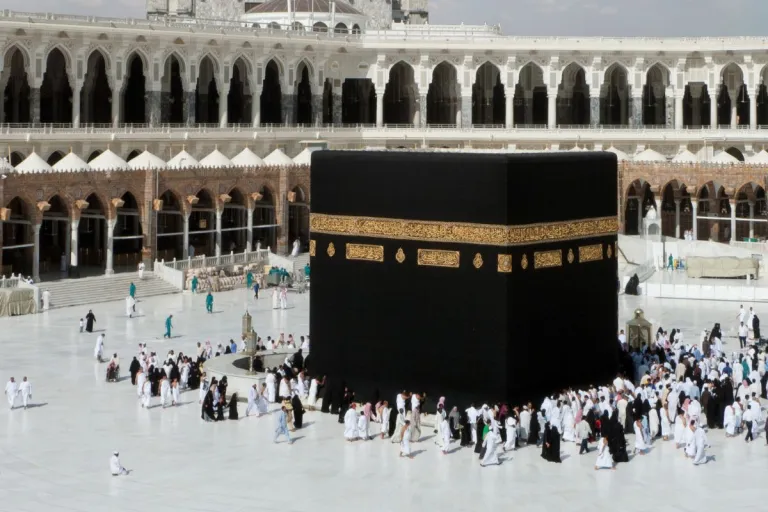Not just Boracay...
Why Is The Floor of Masjid al-Haram Always Cool – Even in Scorching Heat?

For anyone who has set foot in Masjid al-Haram in Makkah, there’s often one curious detail that leaves a lasting impression—how does the white marble floor surrounding the Kaaba stay cool, even under the blazing desert sun?
Many visitors from around the world have experienced it: walking barefoot in the open courtyard on a sweltering day, expecting the ground to be scorching hot… only to be surprised by the cool touch beneath their feet.
Some have speculated that there must be some sort of cooling system underneath—perhaps a network of chilled water pipes hidden beneath the marble. But is that really the case?
Also read: Ultimate Guide to Hajj And Umrah 2025: Essential Tips For First-Time Pilgrims
Not high-tech cooling: Just a clever natural choice
According to an article published by Arab News, the answer isn’t in advanced engineering or modern technology. The secret actually lies in the type of marble chosen for the flooring.
Imported from Thassos, Greece
 Image credit: RMS Marble | Official Website
Image credit: RMS Marble | Official Website
The marble used at Masjid al-Haram is known as Thassos marble, and it comes all the way from the island of Thassos, located in the eastern part of Greece, near the Aegean Sea. This particular type of marble wasn’t selected just for its bright, gleaming appearance—it also has remarkable natural properties.
Unlike regular marble, Thassos marble is known for its ability to reflect sunlight rather than absorb it. Its pure white colour helps bounce off the sun’s rays, preventing the floor from heating up as quickly. In addition, the crystal structure within the marble helps it retain coolness for longer periods, even in extreme heat.
Comfort for millions of pilgrims
 Image credit: Aviator70 | Canva Pro
Image credit: Aviator70 | Canva Pro
For the millions of worshippers who perform tawaf or pray in the vast open areas around the Kaaba, this cool flooring is more than just a marvel of architecture—it’s a true blessing. It provides physical relief, minimises the risk of heat stress, and allows pilgrims to focus on their spiritual experience in greater comfort.
Even though modern technology plays a major role in the maintenance and expansion of Masjid al-Haram, the thoughtful choice of natural materials like Thassos marble shows the care and attention given to every detail—especially when it comes to the well-being of those who visit.
Also read: The Holy Quran Museum: A Must-Visit Experience in Makkah 2025
A fascinating fact for Muslim travellers
For Muslim travellers making their way to Makkah for Hajj, Umrah, or even just a spiritual journey, learning about the story behind the marble floors adds another layer of appreciation. It’s not just about aesthetics—it’s a reflection of how tradition, science, and consideration for others come together in this sacred place.
So the next time you find yourself at Masjid al-Haram, and feel that refreshing coolness under your feet, remember—it’s not hidden pipes or secret machinery, but the brilliance of choosing the right natural material for one of the holiest sites on earth.
Published at
About Author
Aimi Zulkiflee
Subscribe our Newsletter
Get our weekly tips and travel news!
Recommended Articles
10 Best Halal-Friendly Destinations in The Philippines for Muslim Travellers 10 Best Places for Muslim Travellers to See Tulip Festivals in 2025 Fun Fact: Tulips didn’t actually come from the Netherlands but Türkiye!
10 Halal Anime Food Guide for Muslim Travellers in Japan Muslim-friendly versions of popular anime dishes across Japan!
Top 10 Popular Muslim-Friendly Destinations to Visit in 2025 Our schedules are packed, buddies!
10 Halal Restaurants in Bangkok to Satisfy Your Thai Cravings From Korean-style BBQ and Punjabi curries to award-winning shrimp Pad Thai, take your pick from these amazing Halal restaurants in Bangkok.
Latest Articles
The Ultimate Guide For Muslim Travellers to Great Wisteria Festival in Japan You can spot 160-year-old wisteria tree that covers 1,000 sq meters!
Mona Lisa Relocation 2031: What Muslim Travellers Should Know About the Louvre Makeover You can catch Mona Lisa’s smile in under 1 minute!
Penang Airport Launches MyBorderPass: Faster Immigration For 63 Countries Faster customs for 63 countries at Penang Airport!
Travel Alert: Beijing and Northern China Hit by Extreme Winds — Safety Tips Inside China warns people under 50kg to stay indoors amid strong wind alert!
Bali Sets New Rules For Foreign Tourists, Here's What You Need To Know Bali's new rules all foreign tourists need to know before your visit!

